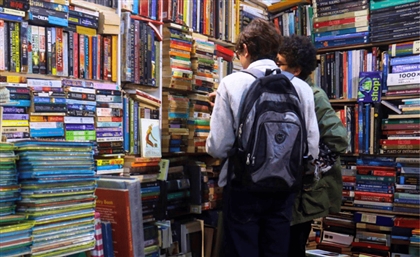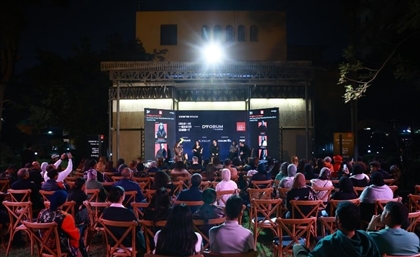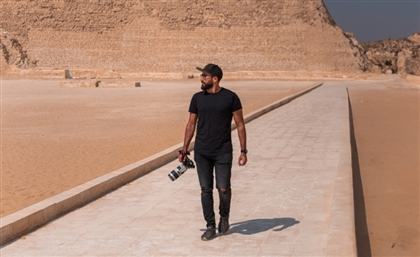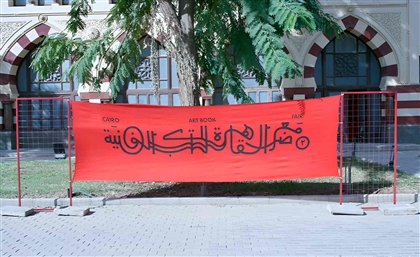What My Grandmother’s Burda Magazines Taught Me About Fashion & Egypt
For decades, my grandmother traced Burda patterns at the dining table. Her sewing charts not only clothed a family but recorded Egypt’s journey from scarcity and self-reliance to fast fashion.
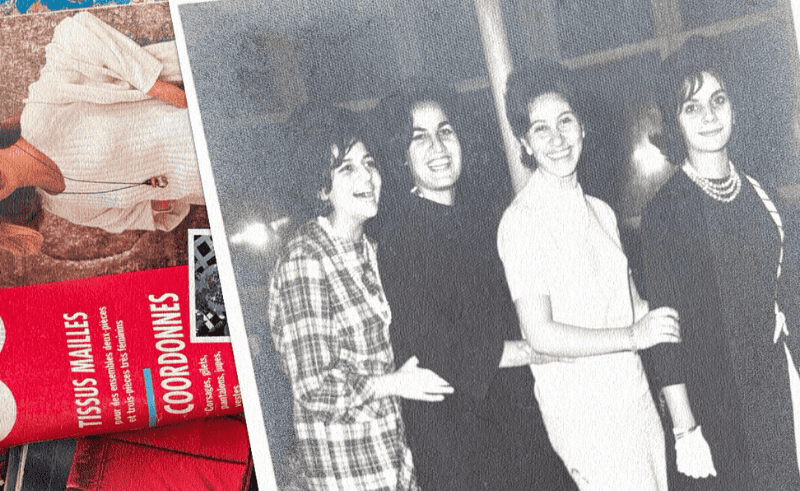
Unlike its neighbours, Egypt never canonised a national dress.The tarboush slipped away after 1952, cast off as an Ottoman remnant; the galabeya lingered in the countryside, and Western suits and skirts stepped in as the new costume of modern life. In the absence of a sanctioned style, clothes moved restlessly between import and imitation, pattern and adaptation.
My grandmother’s stack of Burda magazines, Germany’s mass-market sewing and fashion periodical first printed in 1950 and famous for its pull-out dress patterns, folded and refolded until the paper went soft, was part of that improvised fashion economy, carrying foreign templates cut to measure on an Alexandrian dining table.
Fayza, my grandmother, was born in the 1940s. She comes from the educated middle class of Alexandria, who dressed with care. Her father worked in the Customs Authority, of a Turkish lineage that carried its own ideas of polish and propriety, while her mother was a simple Egyptian woman whose hands knew cloth by feel rather by label. They raised nine children in a crowded, laughing, sometimes frayed household where clothes were made at the family table after meals had just been cleared away.
Their family relied on sewing, mending, and swapping hand-me-downs that fit the next sister with a few smart darts. Her late childhood and teens unfolded under Nasser, a time when the city’s facade settled into an austere, utilitarian modesty: neat skirts, sturdy shirts, work uniforms and school blazers, clothes bought ready-made from state outlets like Stia, offered in just a handful of sober colours. Fashion mirrored the silhouettes of secular working communist countries at the time; functional, uniform, clothing that neither revealed nor concealed too much. In that landscape my grandmother learned that style begins with cut and cloth, not necessarily tags, and that a good seam is one that lies flat, holds under strain, and disappears into the fabric.
For as long as I can remember, my grandmother has lived among her Burda magazines. They traveled with us in suitcases, pressed between folded sweaters, and sat stacked in careful towers on side tables, waiting for her hand. She would sometimes ask me to pass her a particular one; August issue 8, printed in the seventies. She did not only keep the magazines, she used them religiously. In her teens she traced the pull-out patterns to cut dresses for herself, and later for my mom and aunts. Many of my dresses and my cousins’ as well.were sewn from those prototypes, run through a heavy labor-work sewing machine that rattled the floor. To her the magazines were survival tools, treasure chests she kept close. In a home thick with brothers and sisters, under a state that spoke of equality and self-reliance, doing your own sewing was not simply thrifty, it was a way of keeping pace with the demands of life.
For Nana, Burda was never just a fashion magazine. Its pages became guides that showed her how to stretch fabric and imagination through scarcity, and how a clean seam could outlast politics and passing taste.
To understand her story, one must start from a broader fact: in Egypt, clothing has long functioned as language, as social marker, as more than fabric against skin. Clothes move, they sort people, they literally speak. Social forms, objects, and judgments about beauty change continuously through fashion and live in a strange pull between similarity and difference. Fashion operates as both a mirror and mechanism of social hierarchy, a ceaseless dance of imitation and distinction. In the “trickle-down” theory, style begins among the elite, whose innovations are swiftly emulated by the aspiring classes below; once imitation threatens exclusivity, the upper class abandons the look, ensuring status remains visibly marked. When the upper classes fix a line, the lower classes imitate, and in that act of crossing the line the distinction is broken, so the upper classes move the line again. The game continues. I saw this play out in my own city, in shop windows and weddings, in university gates and Friday prayers.
Egypt’s wardrobe has never been a straight line. Imported labels carried social meaning long before my grandmother touched a Burda page. European style entered through magazines, department stores, and elite women. To wear a French name, for the elite, was to announce a place in the world. That was one part of the story. The other part was the economy of home-making: copying and adapting, shifting a neckline to flatter a shoulder, adding a sleeve where none had been, taking a foreign pattern and stitching it into an Egyptian life. That second current is where my grandmother swam and her magazines were a bridge between elsewhere and here, a way to claim a cut without buying into the brand.
I grew up inside the gravity of those magazines. She kept the dressmaker's chalk in a tea tin, pins in a saucer, and a tape measure around her neck like a soft necklace. Offcuts became pockets, the smallest scraps became covered buttons, unpicked zippers lived in a jar that sounded like coins when shaken. On market days she pressed bolts of fabric between finger and thumb, testing weave and fall. “I always believed in dressing those I love,” Fayza always tells me. If a fabric fought the body, it did not deserve the body. If a seam was weak, it needed to be strengthened not discarded.
Her early childhood sits at the tail of the monarchy. In family albums from the late Farouk era you can see the hybridity that defined the period, tarboush and European suit, short dresses on poster girls, fitted coats on winter streets. My grandmother was the child in the background of such frames, hem seldom crooked, hair always polished to a shine.
Her youth took place under Nasser, when imports tightened and state planners spoke of ‘the needle to the rocket,’. In that climate, making one's own clothes was an act of small-scale participation in a larger ideology of self-reliance. This is when Burda became indispensable to her. Often the magazines arrived months late, sometimes with pages missing, but with the patterns she could improvise back into being. She cleared the dining table, laid brown paper down, and traced with a wheel that sang a small dry sound against the grain. She learned to cut a sleeve so it sat cleanly on the shoulder, to angle a dart so the cloth lay smooth against the body; in other words: the politics of the seam, make do, look new.
In those years, Egypt’s rooms carried their own politics: who could afford imports, who sewed by lamplight, who refused to let scarcity dictate how they appeared to the world.
Sadat’s economic opening flooded daily life with objects that had once seemed out of reach: polyester blouses in candy colours, imported perfumes with sharp floral notes, vinyl handbags with stiff little handles, television ads that sold a fantasy of glossed-over abundance. The shopping mall was still a few years away, but the idea of shopping as leisure, as a marker of status rather than necessity, had already taken root. Fortunes were made quickly, families leapt into new brackets of wealth, and with them a fresh hierarchy emerged, stratified not just by income but by the brands one could display. Neighbours started to buy rather than make and my grandmother adapted without surrender. She bought brighter print, she allowed herself a little more swish in a skirt.
Sadat’s presidency introduced a new paradox. On the one hand, his infitah, the “open door” policy, tethered Egypt more firmly to global markets, Gulf capital, and consumer goods; on the other, he loosened the grip of the state on Islamist movements, using them deliberately to check the influence of Nasserists and communists on campuses and in workplaces. It was a two-front strategy: counter the Left by encouraging religious activism at home, while securing alliances with capitalist nations abroad. Thousands of Egyptians traveled to the Gulf in the 1970s, filling the demand for teachers, engineers, and manual laborers generated by the oil boom. They returned not only with remittances and appliances but also with new sensibilities; fans whirring in cramped apartments, perfumes and polyester bought in Riyadh markets, scarves and prayer books that altered the texture of everyday life as Egypt knew it.
The campus Islamist groups of the 1970s, once tolerated, became incubators of a broader cultural revival. Modest dress, study circles, and a vocabulary of piety re-entered Egyptian public space as markers of distinction and moral seriousness, just as shopping malls and satellite channels were promising a different kind of modernity. The prevailing tone at the time, as nana likes to tell me, was simple and confident: if Egypt returned to religion, the war would be won and Sinai would be reclaimed. By the time my grandmother had married a banker, was raising three daughters and had well settled into middle age, she too adopted the hijab in 1982; a turn mirrored by many women of her generation. Through these years of turn and return, piety in public, prosperity on television, Burda remained her counterbalance.
The magazines were handbooks for negotiating a modesty that was chosen as much as imposed. She tried to coax modesty out of patterns that were never designed for it, lengthening hems, stitching on sleeves, tugging at necklines that never really behaved. The results of success and failure with compromises announcing themselves too loudly, that was well before polyester undergarments arrived to smooth over the gaps and add their own small catastrophes to the silhouette.
Mubarak’s years bloomed into glass corridors. Cairo became a theater of mannequins. New Cairo, Nasr City, 6th of October, everywhere a promise of the latest, everywhere the multiply stamped paper bag with rope handles. Came the food court lunches and window shopping, came the price of a logo, and the seam that can give up after one wash. I also learned to hear the small click of her tongue when a hem was glued not sewn, the thin smile when a knit pilled too fast. The skirt that twisted, the strap that snapped, the sleeve that pinched, all came back with a logic restored. My grandma was not purist either; She could love a fast fashion jacket and still criticise its lining. She could admire a designer label and still raise an eyebrow at a loose thread and whenever I staged a meltdown over some shop-window dress, she’d laugh it off with her usual line: “هعملك أحلى منه”—I’ll make you one better.
Those decades were not only about buying and mending as much as they were also about a new social map of dress. In the same street one could see cropped tops and niqab, neon trainers and high platforms, loose trousers and pencil skirts, a baseball cap turned backward and a silk scarf pinned under the chin. In campuses the conversation grew sharper: As skirts and sleeve-cuts faded, fitted blouses and jeans took their place, alongside fully veiled students. Religious debates spilled into newspapers, television panels, faculty meetings, conversations at gates with rise of modest looking new wave islamic preachers. Voices sometimes fretted about imported immorality, some urged bans, others defended personal choice. Modestwear moved from symbol of resistance and piety to a polished style linked to middle class success, with new abaya styles emerging and color matched scarves, chains of veiling stores alongside lingerie windows that dared the eye. A cycle of borrowing and differentiating kept revolving.
Egypt never truly embraced a national dress. That absence has shaped how dress and identity are read: what counted as “Egyptian” fashion has always swung between imported trends and fragments of local craft. A handful of cultural figures and designers began reviving village wardrobes and re-styling the galabeya as heritage. Their work preserved silhouettes and embroidery that might otherwise have disappeared among the more affluent classes in Egypt, but a 6 figure brass necklace also became a marker of status as of authenticity. By the turn of the millennium, a new wave of ateliers translated hand-loomed cottons and rural patterns into streamlined urban garments, often carrying price tags far beyond the reach of the communities that once produced them. The impulse to honor Egypt’s dress traditions is genuine, yet the market frequently recasts those traditions as luxury goods, at once preserving and estranging them from the everyday lives they grew out of. In that absence, many of us reached for signals that traveled faster, a polo pony on a shirt, a monogram on a bag, a sneaker sole that proclaimed a price to those who knew.
I return to the theory to make sense of my own appetite. Fashion as a field where dominant actors decide what counts as limited edition, how value is created, and how newcomers respond by challenging or copying those rules. I see this too, not only in Paris, but in Cairo’s Instagram boutiques, in limited runs that promise exclusivity, in local brands that blend Egyptian cotton with imported trims and Gulf tastes to sell a hybrid that photographs well and travels easily. People say sustainability now, and they mean fewer plastic bags, fewer cheap buys, fewer returns. For my grandmother it was never a trend but a habit, use what you have, make it last, do not discard what can be rescued, buy better when you can, and mend always. She never called a garment sustainable, she calls it useful.“ينفعك دايما (Ynf3ek dayman)” as “may it always serve you”. Useful keeps you honest and asks what your day needs.
Trending This Week
-
Dec 12, 2025








